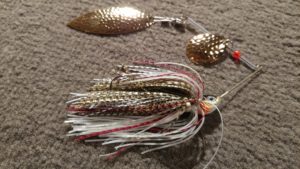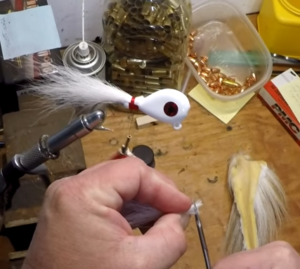How to Tie a Silicone Finesse Jig
![]() Learning how to tie a silicone finesse jig can be a bit tricky if you’re new to this method of tying. It’s not necessarily difficult to do. But there are a few little tips and tricks that can make it much easier to do, especially for the neophyte.
Learning how to tie a silicone finesse jig can be a bit tricky if you’re new to this method of tying. It’s not necessarily difficult to do. But there are a few little tips and tricks that can make it much easier to do, especially for the neophyte.
Our video below will show you all of the steps involved. And by the time you’re finished watching, you’ll know how to tie a silicone finesse jig with no problems at all. You may not be a pro, necessarily, but you’ll be well on your way to doing it easily.
Tying your own jigs will give you the benefit of being able to create them exactly the way you want them to look. So you ‘re not limited to the selection available from a retail store.
Finesse jigs excel for bass when the conditions are tough, especially after a cold front or when the water is extremely cold. The smaller profile will be more likely to get bit when bulkier lures get ignored. Keep this in mind when you’re fishing under tough conditions.
We have listed everything you need at the end of this post, but just to give you a heads up, you’ll be needing a fly tying vice, a small bass jig, some silicone skirt tabs and some fly tying thread.
Smalljaw, the creator of the tutorial video, goes into some good detail with what he likes to use for skirt material, thread and glue. And since he’s been at this for quite a while, we can take his advice as being solid, not just theory.
Choose Your Colors Carefully
![]() Tying the jig in the video requires only two colors, so you won’t need a huge selection of silicone skirt tabs. But choose your colors carefully. The idea with a finesses jig is usually to create something very natural looking.
Tying the jig in the video requires only two colors, so you won’t need a huge selection of silicone skirt tabs. But choose your colors carefully. The idea with a finesses jig is usually to create something very natural looking.
But don’t be afraid to experiment a bit. Sometimes a specific lake will call for an odd color combination that most people wouldn’t even think of using. And if you can find that color combination, you will catch fish that most people will miss out on.
Check out the video tutorial below and then get yourself busy tying some custom silicone finesse jigs. The next time the bite gets tough, you’ll be glad you did!
Items used for this project:
- Football Jig Head
- Silicone Skirt Material
- Nature’s Edge Silicone Skirt Material
- Waxed 210 Denier Thread
- Fly Tying Vise
- Fly Tying Scissors
If you enjoyed this post, please be sure to like it and share it with your friends.
If you’d like to learn how to make spinnerbaits for bass, click here.
And, as always, if you need any kind of lure-making supplies, be sure to visit our website, at http://lurepartsonline.com

 How to Pour Lead Head Jigs
How to Pour Lead Head Jigs Now that the jig head is poured and the paint is cured, it’s time to put the eyes on!
Now that the jig head is poured and the paint is cured, it’s time to put the eyes on! If you’re a hardcore Musky angler, you will undoubtedly want to learn How To Build a Double Cowgirl Musky Inline Spinner.
If you’re a hardcore Musky angler, you will undoubtedly want to learn How To Build a Double Cowgirl Musky Inline Spinner.

 Whether you fish in freshwater or saltwater, knowing How to Tie Your Own Bucktail Jigs is an important skill to have.
Whether you fish in freshwater or saltwater, knowing How to Tie Your Own Bucktail Jigs is an important skill to have.